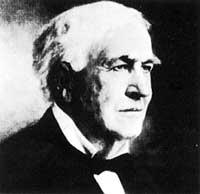Recent searches
Elhuyar Fundazioa
This American inventor entered the world of Milan (Ohio) on February 11, 1847. In his family there was not much money and he had to start working from a young age. When he began reading scientific books, he installed a laboratory at home. To get money for the lab, he sold newspapers on the train that ran the route between Port Huron and Detroit (Michigan).
In 1862 he went to work in the telegraphy offices of Port Hurón. There he invented the double telegraph. With this invention he gained fame and a lot of money. Therefore, in 1876 he founded the company Menlo Park. In that company he made many inventions. At death he had 1,100 patented inventions.
His most important invention is the phonograph (1877). But it also has many other outstanding inventions. Among them, the microphone in 1877, the incandescent lamp in 1878, the quinetoscope and some telegraphic devices in 1894.

In 1878 he pointed out that he was going to solve the problem of electricity generation. Previously other inventors also sought the solution to this problem, but did not succeed. British chemist Swan invented an incandescent carbon filament lamp. However, inside the bulb the filament did not have enough vacuum and burned with oxygen from the air. Faced with this problem, Edison began to look for another wire. For a long time he worked with platinum, but eventually realized that he wasn't looking.
After many other tests, he realized that the filament was not mandatory in metal. Therefore, he tried with the cotton filament of the semi-literates and could find a solution. In 1879 he created a bulb with that filament. From that moment on, electric light was a reality. The Old Year showed its discovery illuminating the main street of Menlo Park. Journalists from around the world gathered. For Edison this was the most important moment of his life.
But the electrical light sessions were not like that. In order to use the electric light he invented the electric generator in 1881.
In 1883 he tested the improvement of electric light, introducing a metal wire next to the hot filament of the bulb. He discovered that the electricity passed from the hot filament, through the gap separating the filament and the wire, to the metal wire, that is, to vacuum and at high temperatures the metals emitted electrons. This is called the Edison effect or thermoion effect and is the basis of the operation of electronic tubes and valves.
In 1889 it began in other essays. In them he projected successively the photos to a screen to give it the feeling of movement. He used the type of film invented by Eastman.
Tomás Alva Edison died in West Orange (New Jersey) on October 18, 1931.





